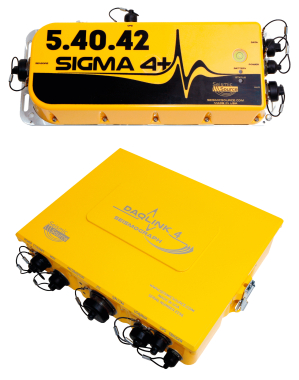Sigma-4 and DAQLink4 – seismographs for high-resolution seismic operations in the water area
The advanced characteristics of Sigma-4 and DAQlink-4 seismographs allow them to be deployed for all types of modern high-resolution offshore seismic operations, which are usually used to identify possible geological hazards during drilling, construction of wind farms, pipeline routes, dredging and other tasks arising in the water area.
High-frequency seismic sources, such as sparkers and boomers, impose a requirement on the sampling frequency of the recorded signal, which should be at least 16 kHz. In addition, high-resolution seismic surveys imply a small step between the shot points and continuous recording. Sigma-4 and DAQlink-4 have no restrictions on the recording length and number of channels, what makes them an ideal solution for high-resolution 2D / 3D marine seismic surveys and especially when implementing multi-source and code pulse shooting, which are supported by MultiJack energy sources. A direct network connection provides an immediate access to data for real-time visualization and analysis using RadExPro Real-Time software.
Sigma-4 with four recording channels is effective for performing HR / UHR surveys with HRStreamer-1. The number of channels in a single DAQlink-4 recorder can be 6, 12 or 24, but the system configuration allows its users to increase it by combining blocks via Ethernet or Wi‑Fi connection. The GNSS receiver connected to the seismograph provides time synchronization and records the current coordinates and time in the headers.
DAQlink-4 together with BHStreamer multichannel streamer, can be used to monitor the level of seismic noise during surveys with autonomous bottom seismographs. In this scenario, the station with a built-in FTP server is located on an anchored autonomous buoy equipped with capacious batteries, a data storage device, a Wi-Fi/GSM access point and a cable connector with a bottom streamer. In order to properly formulate technical specs that might be needed for purchase / rental of such a system, please contact us in any way indicated on the website.
Some distinctive features of DAQlink-4:- Combining stations into an array via Wi-fi, Ethernet, and other methods
- Managing, configuring, registering, and downloading data via Wi-Fi, 100 Mbps Ethernet, or mobile connection
- Built-in FTP server
- Applicability for monitoring the level of microseisms when working with autonomous bottom seismic stations (nodes)
- Any recording duration up to continuous measurement
- Saving data in SEG 2, SEG D, SEG-Y, ASCII or MiniSEED
- Wide frequency range (0 ÷ 20 000 Hz) and low noise
- Possibility to install 16 GB of internal memory for offline data logging and connect a flash drive for backup and data transfer
- Built-in tools for testing seismographs (nonlinear harmonic distortion coefficient, crosstalk between channels, common mode rejection, inherent noise level) and geophones (resistance, frequency, attenuation, sensitivity)
|
Number of channels in one seismograph |
4, 6, 12 or 24 |
|
ADC |
24 bit |
|
Dynamic range |
124 dB (at 500 Hz) |
|
Gain ratio |
0 or 24 dB |
|
Sampling rate |
125; 250; 500; 1000; 2000; 4000; 8000; 16000; 48000; 64000 Hz |
|
Frequency range |
0 ÷ 20 000 Hz |
|
Anti-aliasing filter |
85% of Nyquist rate |
|
High-frequency filter |
0.001 ÷ 120 Hz (can be chosen) |
|
Filter type |
linear-phase |
|
Accuracy |
±1 (500 Hz) mc S |
|
Maximum input signal with minimum gain |
±3.7 V |
|
Inherent noise level of registering channel |
<0.2 μV (at 500 Hz) |
|
Nonlinear harmonic distortion coefficient |
0.00008 %(at 500 Hz) |
|
Crosstalk between channels |
-125 dB |
|
Common-mode rejection ratio |
100 dB (at 500 Hz) |
|
Power consumption |
0.13 W/channel |
|
Self-impedance |
100 kOhm |
|
Time synchronization |
GPS-reciever or VNF |
|
Storage capacity of information (internal memory 16 Gb CF) |
120 hours (24 channels at 500 Hz) |
|
Storage capacity of information (via Ethernet or external USB) |
Unlimited |
|
Data format |
SEG-2, SEG-D, SEG-Y, ASCII, MiniSEED |
|
LEDs |
Network connection status, unit status and the battery level |
|
Power source |
10 ÷ 28 V DC |
|
Temperature range |
-40 ÷ +85 °C |
|
Humidity range |
0 ÷ 100 % |
|
Overall dimensions (DAQlink-4) |
245 х 340 х 75 mm |
|
Weight (DAQlink-4) |
3.2 kg |
|
Overall dimensions (Sigma-4) |
355 х 145 х 70 mm |
|
Weight (Sigma-4) |
1.5 kg |











